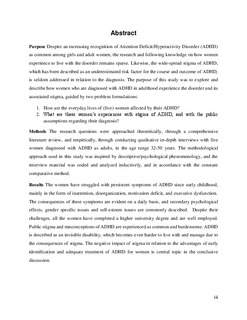| dc.description.abstract | Purpose: Despite an increasing recognition of Attention Deficit/Hyperactivity Disorder (ADHD) as common among girls and adult women, the research and following knowledge on how women experience to live with the disorder remains sparse. Likewise, the wide-spread stigma of ADHD, which has been described as an underestimated risk factor for the course and outcome of ADHD, is seldom addressed in relation to the diagnosis. The purpose of this study was to explore and describe how women who are diagnosed with ADHD in adulthood experience the disorder and its associated stigma, guided by two problem formulations:
How are the everyday lives of (five) women affected by their ADHD?What are these women’s experiences with stigma of ADHD, and with the public assumptions regarding their diagnosis?
Methods: The research questions were approached theoretically, through a comprehensive literature review, and empirically, through conducting qualitative in-depth interviews with five women diagnosed with ADHD as adults, in the age range 32-50 years. The methodological approach used in this study was inspired by descriptive/psychological phenomenology, and the interview material was coded and analyzed inductively, and in accordance with the constant comparative method.
Results: The women have struggled with persistent symptoms of ADHD since early childhood, mainly in the form of inattention, disorganization, motivation deficit, and executive dysfunction. The consequences of these symptoms are evident on a daily basis, and secondary psychological effects, gender specific issues and self-esteem issues are commonly described. Despite their challenges, all the women have completed a higher university degree and are well employed. Public stigma and misconceptions of ADHD are experienced as common and burdensome. ADHD is described as an invisible disability, which becomes even harder to live with and manage due to the consequences of stigma. The negative impact of stigma in relation to the advantages of early identification and adequate treatment of ADHD for women is central topic in the conclusive discussion. | nb_NO |
